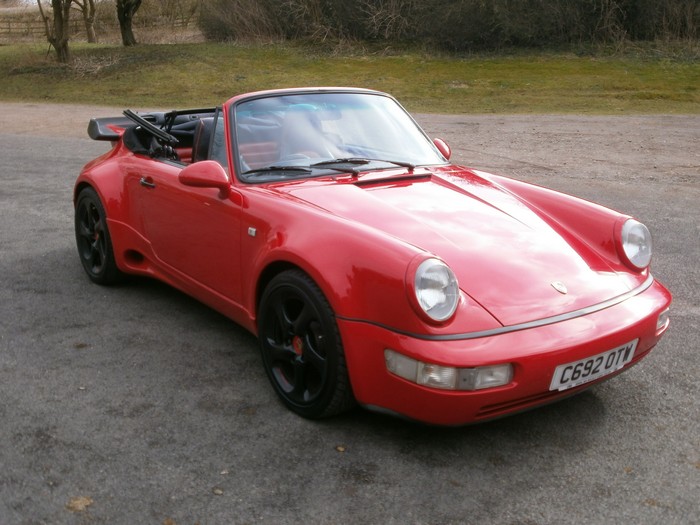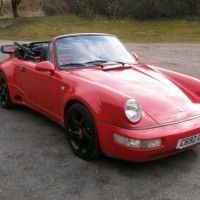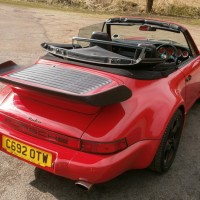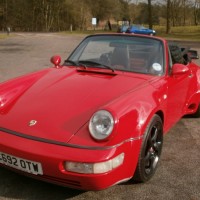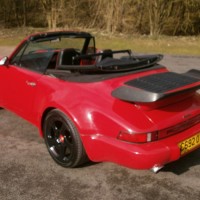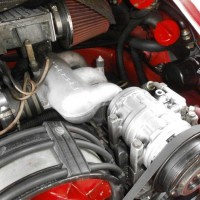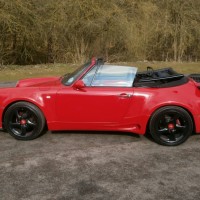SCM Analysis
Detailing
| Vehicle: | 1986 Porsche 911 Carrera 3.2 Supersport cabriolet |
| Number Produced: | 3,645 total Turbo-looks, including 1,708 cabriolets and 311 RHD cabs |
| Original List Price: | $50,500 before options |
| SCM Valuation: | $19,000 to $23,000 |
| Chassis Number Location: | Inner left front fender aluminum plate; stamping above fuel tank |
| Engine Number Location: | Under fan on right side upright |
| Club Info: | Porsche Club of America |
| Website: | http://www.pca.org |
This car, Lot 315, sold for $28,488, including buyer’s premium, at Bonhams’ April 29 auction at the Royal Air Force Museum in London.
On its face, this sale looks like one smoking-hot deal, but this is not necessarily the case.
The car is an unusual one for SCM to profile in that it is a modified car — something that often is akin to a death rattle in the Porsche collector-car world. That said, the car does provide an interesting base on which to assess the 911 “Supersport” option package (a term used only in the U.K. market — as it was “Turbo-look” everywhere else) and also present our take on modified 911s.
The almost bulletproof Carrera
The base car here was the almost-bulletproof 3.2-liter Carrera, a model built between 1984 and 1989 that closely followed the pattern of the previous model 1978–83 SCs. The engine in the 1978–83 cars was a 3.0-liter version of the famed flat 6-cylinder 911 powerplant. The 3.2 Carrera was considered an advance for a variety of reasons, other than the additional 200 ccs. There were many small improvements — and two big ones:
First was the addition of hydraulic cam-chain tensioners, a move that virtually eliminated a frequently terminal engine problem. Second was the 1987 introduction of the heavier-duty, smoother-shifting Getrag-built G50 gearbox, which Porsche dubbed its Type 950.
These cars were also the last to carry the body configuration introduced first in 1974 with the advent of the federal crash-resistant bumpers — aka the “high-bumper” 911s. Whether 16 years of very similar outward appearance was a good thing we will not debate here. There was little disagreement, however, that it almost killed Porsche. Looking back today, people are gradually becoming much more forgiving of — even nostalgic for — that long-running design.
The relatively scarce Turbo-look Carrera
Among high-bumper 911 cognoscenti, the Turbo-look optioned cars hold an esteemed place. Essentially, the option package offered buyers a 911 Turbo wide-body of flared-out fenders, wider wheels, the Turbo’s suspension and brake upgrades, and the Turbo rear wing — all with the normally aspirated 911 engine.
That engine was 231 horsepower for the world market, but just 200 hp to 207 hp in emissions-modified form for the U.S. and Japan. The horsepower was bumped to 214 to 217 hp in 1987 after remapping the engine.
The Turbo-look Carreras appealed to people who feared turbo lag or did not want that potential additional maintenance — while still lusting for the Turbo’s wide-body look and the mechanical upgrades. The option was known as M491, a designation Porsche used since the 1970s to indicate a high-performance or racing model. It was a bit of a misnomer here.
The Turbo-look package definitely improved drivability of the 911. However, the bigger body and mechanics, wheels, and tires added weight — perhaps 150-plus pounds. Acceleration suffered. And it was not inexpensive, adding about $14,000* to the Carrera cabriolet’s base price of $36,450, or as is more likely, $41,301 after popular options, per Road & Track’s January 1986 road test. As a result, the Turbo-look option also was not terribly common. The Carrera 3.2 production run totaled 49,629 cars, of which Turbo-looks accounted for 3,645, or about 7.3% of production.
Small differences can add value
That “not terribly common” part often has a strong effect on price some years later. Even small differences in fairly high-production models can translate into desirability and, subsequently, value. So it has been with Turbo-look cars. Here in the United States, a few years ago the model was worth $5,000 extra on a typical $25,000 price for a lower-mileage, all-original 3.2 Carrera. The difference now is more like 50%. Some market-savvy dealers were on to them early, and one or two even made a specialty of it. Today, the supply of high-quality, all-original, low-mileage Turbo-look cars is becoming thin.
Our Bonhams auction subject car gets plus points for desirability. It also gets a plus point for being the first year of the electrically actuated cabriolet top. The car gets a ding for being a model year before the improved G50 gearbox. It earns another, bigger ding for being high mileage — at 95,600 miles showing — with no discussion of maintenance.
This example also had been modified, and that is a big diminution in value. Further, the modifications were not especially well chosen: later body bumpers off a 964/965; aftermarket rocker panels with an air inlet hole ahead of the rear wheel openings; and black-painted wheels. One of the nine previous owners also had horsepower envy, as he stuck a “Turbo” name plate on the rear deck. As presented, our desirable Turbo-look Carrera 3.2 is more of an individualized café racer. And for many people the too-common Guards Red paint is a negative.
911 mods diminish value
When do modifications to a 911 hurt or help its value? As a rule, modifications diminish value — usually substantially. The factory built 911s so well that few people value modifications — even if they are well-chosen and well-executed ones. The classic 911 market especially prizes originality — the more, the better. A matching-engine/gearbox, all-original-paint-and-trim 911 might double the price of a street concours car that carried replacement or reproduction pieces and mismatched mechanical components.
Some R Gruppe 911s pose a dilemma. R Gruppe is a limited-membership, loosely organized, “outlaw” or hot-rod low-bumper 911 club. Most of their cars have been tastefully done, and are frequently patterned after a factory-built, limited-production model such as a 1967 911R, 1970–72 ST, 1973 RS or RSR — with creative mixing and matching and possibly updated mechanicals.
I like well-executed R Gruppe cars. Some of those cars justify price premiums reflective of excellent workmanship and drivability. However, such cars are exceptions to the rule that modifications usually diminish a 911’s value.
My bottom line is that the Bonhams Turbo-look cab was a pig with lipstick. I consider it fairly bought and sold at just $28,488, but we’d have to admit that the price does allow for possibly refurbishing back to stock Turbo-look without being buried in the car. However, the high mileage might be a possible stumbling block. ?
(Introductory description courtesy of Bonhams.)
*The Turbo-look option cost between DM24,900 ($8,749) in 1984, up to DM29,790 ($15,846) in 1989. In 1986 it was DM27,950 ($12,871), at which point the deutsche mark averaged about two per dollar, with meaningful fluctuations in the period.
